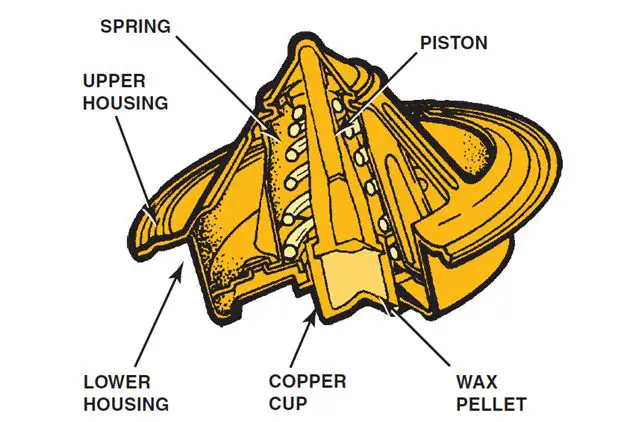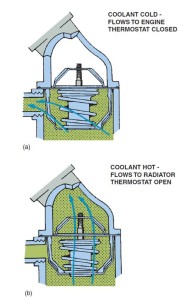Purpose and Function
There is a normal operating temperature range between low-temperature and high-temperature extremes. The thermostat controls the minimum normal temperature. The thermostat is a temperature-controlled valve placed at the engine coolant outlet on most engines.
Thermostat Operation
An encapsulated wax-based plastic pellet heat sensor is located on the engine side of the thermostatic valve. As the engine warms, heat swells the heat sensor.

A cross section of a typical wax-actuated thermostat showing the position of the wax pellet and spring
A mechanical link, connected to the heat sensor, opens the thermostat valve. As the thermostat begins to open, it allows some coolant to flow to the radiator, where it is cooled. The remaining part of the coolant continues to flow through the bypass, thereby bypassing the thermostat and flowing back through the engine.

(a) When the engine is cold, the coolant flows through the bypass. (b) When the thermostat opens, the coolant can flow to the radiator
The rated temperature of the thermostat indicates the temperature at which the thermostat starts to open. The thermostat is fully open at about 20°F higher than its opening temperature.
If the radiator, water pump, and coolant passages are functioning correctly, the engine should always be operating within the opening and fully open temperature range of the thermostat.
Thermostat Testing
Thermostat Testing
There are three basic methods used to check the operation of the thermostat.
1. Hot water method. If the thermostat is removed from the vehicle and is closed, insert a 0.015 in. (0.4 mm) feeler gauge in the opening so that the thermostat will hang on the feeler gauge. The thermostat should then be suspended by the feeler gauge in a container of water or coolant along with a thermometer. The container should be heated until the thermostat opens enough to release and fall from the feeler gauge. The temperature at which the thermostat falls is the opening temperature of the thermostat. If it is within 5°F (4°C) of the temperature stamped on the thermostat, the thermostat is satisfactory for use. If the temperature difference is greater, the thermostat should be replaced.
2. Infrared thermometer method. An infrared thermometer (also called a pyrometer) can be used to measure the temperature of the coolant near the thermostat. The area on the engine side of the thermostat should be at the highest temperature that exists in the engine. A properly operating cooling system should cause the pyrometer to read as follows:
- As the engine warms, the temperature reaches near thermostat opening temperature.
- As the thermostat opens, the temperature drops just as the thermostat opens, sending coolant to the radiator.
- As the thermostat cycles, the temperature should range between the opening temperature of the thermostat and 20°F (11°C) above the opening temperature.
NOTE: If the temperature rises higher than 20°F (11°C) above the opening temperature of the thermostat, inspect the cooling system for a restriction or low coolant flow. A clogged radiator could also cause the excessive temperature rise.
3. Scan tool method. A scan tool can be used on many vehicles to read the actual temperature of the coolant as detected by the engine coolant temperature (ECT) sensor. Although the sensor or the wiring to and from the sensor may be defective, at least the scan tool can indicate what the computer “thinks” is the engine coolant temperature.
Next Steps towards ASE Certification
Now that you’re familiar with Diesel Engine Thermostats, try out our free Automotive Service Excellence Tests to see how much you know!
![ASE Certification Training HQ - Free ASE Practice Tests [Updated 2021]](https://asecertificationtraining.com/wp-content/themes/simplefolio/images/ASE Certification Logo.png)

